












Scaly-breasted Lorikeet, Trichoglossus Chlorolepidotus, is a
medium sized lorikeet (22cm to 25cm in length).
Colour is an overall green, feathers on chest and shoulders edged in yellow
giving a scaly appearance, tail green and green/yellow under, blue tinge
on head (more prominent in male), underwing red, beak red, eyes red/orange.
Young birds have lighter orange beak and light grey ring in eye that develops
into an orange ring as they get older.
About one in every four to six Scalys will be of the Olive variety. Less common
are Yellow (lutino) and Cinnamon types and extremely rare are blue Scalys.
The Scaly-breasted Lorikeet is one of the most popular small lorikeets in
New Zealand aviculture. ALthough most breeders are quite successful with
their Scalys we have had very limited success during 2001 and most of 2001.
An established breeding pair we purchased in May 2000 failed to produce fertile
eggs and when fertile eggs were laid they were abandoned. One such egg was
placed under Rainbow lorikeets and successfully hatched. Unfortunately due to
our inexperience in dealing with foster parents this chick died after being
aaabandoned at 3 weeks old by the Rainbows (we did not know that fostered
eggs/chicks should be removed after 10 to 15 days and hand raised). Before this
pair of Scalys could produce any more fertile eggs the lutino female was
lost.
We had to wait until June/July 2001 when some of the lutino's offspring from
1999/early 2000 were old enough to pair off with other scalies and lay eggs.
In the space of two months we had seven baby scalies, one Olive, four Greens,
one Lutino and one Cinnamon. The wait was definitely worthwhile especially
for the Lutino and Cinnamon, both of which appear to be quite uncommon in
New Zealand aviculture.
In December 2001 another Scaly was hatched and this one from the same parents
as the Cinnamon and Lutino. This hatchling also has red eyes so if it develops
normally it should be either another Lutino or Cinnamon.
From the day Olive and Sweetie arrived at the avairy they were very inquisitive
and would immediately fly to the nearest human. They will clean fingernails,
inspect and lick ears in great detail and just love getting into and crunching
up a wine or malt biscuit reducing it to dust in minutes.
Sweetie will learn new sounds quite quickly and will lead Olive in
leaning forward from a shoulder to closely inspect lips that are talking
or whistling. Blowing raspberries gets then real excited and they will hop
up and down or bob so fast they will sometimes loose grip and fall over.
These two birds prove that Scaly breasted Lorikeets are amongst the most
friendly, inquisitive and intelligent lorikeets, excellent pets.













|
28 May 2000
A major addition to our family of Lorikeets happened today. We set off
to find another female scaly to replace Sweetie who was Olive's
mate. Olive has become quite withdrawn since we lost Sweetie and it is
obvious that he is missing her.
On arrival at the aviaries where we planned to buy a Scaly we discovered that
the breeder had decided to sell off all of his birds. A quick decision later,
and a visit to several hole-in-the-wall machines to get $, we were driving
home with a breeding pair of Scalys, their last five offspring, a male Olive
Rainbow and it's mate a Green Scaly. Plus seven nicely constructed L shape
nestboxes.
The breeding pair of Scalies are unusual in that the female is yellow (lutino)
with some slight red colouring on her neck, the male is a normal green
scaly.
Images below are of some of the green offspring of this pair.
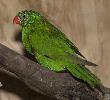
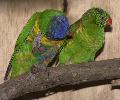
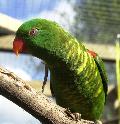
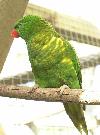
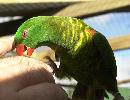
|
Click on image below to display full size

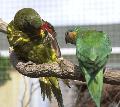

|
Click on image below to display full size
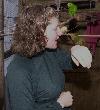
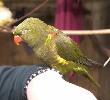
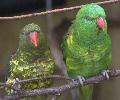

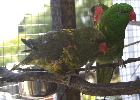
|
July 2001
Our first baby scalies were hatched this month, two pairs at almost the same
time. One pair is an olive and a green and the other two greens. A week
after these a third pair, a cinnamon and a green, were hatched.
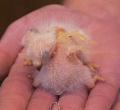
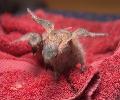



|
